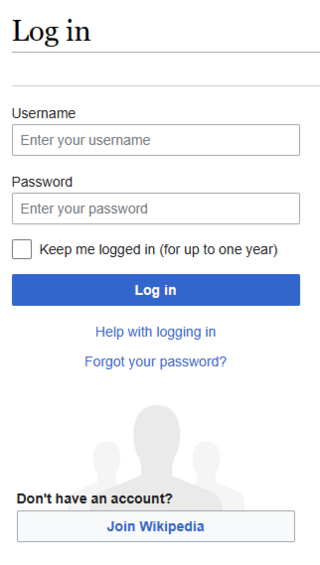| Stable release | 1.5.3 / May 8, 2023 |
|---|---|
| Repository | https://github.com/linux-pam/linux-pam |
| Written in | C |
| Operating system | Linux |
| Type | authentication |
| License | GNU General Public License or Modified BSD License |
| Website | www |
Linux Pluggable Authentication Modules (PAM) is a suite of libraries that allow a Linux system administrator to configure methods to authenticate users. It provides a flexible and centralized way to switch authentication methods for secured applications by using configuration files instead of changing application code. [1] There are Linux PAM libraries allowing authentication using methods such as local passwords, LDAP, or fingerprint readers. [2] Linux PAM is evolved from the Unix Pluggable Authentication Modules architecture. [3]
Linux-PAM separates the tasks of authentication into four independent management groups: [4]
Kerberos is a computer-network authentication protocol that works on the basis of tickets to allow nodes communicating over a non-secure network to prove their identity to one another in a secure manner. Its designers aimed it primarily at a client–server model, and it provides mutual authentication—both the user and the server verify each other's identity. Kerberos protocol messages are protected against eavesdropping and replay attacks.
The Secure Shell Protocol (SSH) is a cryptographic network protocol for operating network services securely over an unsecured network. Its most notable applications are remote login and command-line execution.
SOCKS is an Internet protocol that exchanges network packets between a client and server through a proxy server. SOCKS5 optionally provides authentication so only authorized users may access a server. Practically, a SOCKS server proxies TCP connections to an arbitrary IP address, and provides a means for UDP packets to be forwarded.

passwd is a command on Unix, Plan 9, Inferno, and most Unix-like operating systems used to change a user's password. The password entered by the user is run through a key derivation function to create a hashed version of the new password, which is saved. Only the hashed version is stored; the entered password is not saved for security reasons.

A pluggable authentication module (PAM) is a mechanism to integrate multiple low-level authentication schemes into a high-level application programming interface (API). PAM allows programs that rely on authentication to be written independently of the underlying authentication scheme. It was first proposed by Sun Microsystems in an Open Software Foundation Request for Comments (RFC) 86.0 dated October 1995. It was adopted as the authentication framework of the Common Desktop Environment. As a stand-alone open-source infrastructure, PAM first appeared in Red Hat Linux 3.0.4 in August 1996 in the Linux PAM project. PAM is currently supported in the AIX operating system, DragonFly BSD, FreeBSD, HP-UX, Linux, macOS, NetBSD and Solaris.
S/KEY is a one-time password system developed for authentication to Unix-like operating systems, especially from dumb terminals or untrusted public computers on which one does not want to type a long-term password. A user's real password is combined in an offline device with a short set of characters and a decrementing counter to form a single-use password. Because each password is only used once, they are useless to password sniffers.
OpenVPN is a virtual private network (VPN) system that implements techniques to create secure point-to-point or site-to-site connections in routed or bridged configurations and remote access facilities. It implements both client and server applications.
Single sign-on (SSO) is an authentication scheme that allows a user to log in with a single ID to any of several related, yet independent, software systems.
Java Authentication and Authorization Service, or JAAS, pronounced "Jazz", is the Java implementation of the standard Pluggable Authentication Module (PAM) information security framework. JAAS was introduced as an extension library to the Java Platform, Standard Edition 1.3 and was integrated in version 1.4.
NX technology, commonly known as NX or NoMachine, is a remote access and remote control computer software, allowing remote desktop access and maintenance of computers. It is developed by the Luxembourg-based company NoMachine S.à r.l.. NoMachine is proprietary software and is free-of-charge for non-commercial use.
3-D Secure is a protocol designed to be an additional security layer for online credit and debit card transactions. The name refers to the "three domains" which interact using the protocol: the merchant/acquirer domain, the issuer domain, and the interoperability domain.
In computer science, session hijacking, sometimes also known as cookie hijacking, is the exploitation of a valid computer session—sometimes also called a session key—to gain unauthorized access to information or services in a computer system. In particular, it is used to refer to the theft of a magic cookie used to authenticate a user to a remote server. It has particular relevance to web developers, as the HTTP cookies used to maintain a session on many websites can be easily stolen by an attacker using an intermediary computer or with access to the saved cookies on the victim's computer. After successfully stealing appropriate session cookies an adversary might use the Pass the Cookie technique to perform session hijacking. Cookie hijacking is commonly used against client authentication on the internet. Modern web browsers use cookie protection mechanisms to protect the web from being attacked.
There are a number of security and safety features new to Windows Vista, most of which are not available in any prior Microsoft Windows operating system release.

In computer security, logging in is the process by which an individual gains access to a computer system by identifying and authenticating themselves. The user credentials are typically some form of username and a matching password, and these credentials themselves are sometimes referred to as alogin. In practice, modern secure systems often require a second factor such as email or SMS confirmation for extra security. Social login allows a user to use existing user credentials from a social networking service to sign in to or create an account on a new website.
A number of computer operating systems employ security features to help prevent malicious software from gaining sufficient privileges to compromise the computer system. Operating systems lacking such features, such as DOS, Windows implementations prior to Windows NT, CP/M-80, and all Mac operating systems prior to Mac OS X, had only one category of user who was allowed to do anything. With separate execution contexts it is possible for multiple users to store private files, for multiple users to use a computer at the same time, to protect the system against malicious users, and to protect the system against malicious programs. The first multi-user secure system was Multics, which began development in the 1960s; it wasn't until UNIX, BSD, Linux, and NT in the late 80s and early 90s that multi-tasking security contexts were brought to x86 consumer machines.

OpenSSH is a suite of secure networking utilities based on the Secure Shell (SSH) protocol, which provides a secure channel over an unsecured network in a client–server architecture.
SAP Logon Tickets represent user credentials in SAP systems. When enabled, users can access multiple SAP applications and services through SAP GUI and web browsers without further username and password inputs from the user. SAP Logon Tickets can also be a vehicle for enabling single sign-on across SAP boundaries; in some cases, logon tickets can be used to authenticate into 3rd party applications such as Microsoft-based web applications.
Cross-site request forgery, also known as one-click attack or session riding and abbreviated as CSRF or XSRF, is a type of malicious exploit of a website or web application where unauthorized commands are submitted from a user that the web application trusts. There are many ways in which a malicious website can transmit such commands; specially-crafted image tags, hidden forms, and JavaScript fetch or XMLHttpRequests, for example, can all work without the user's interaction or even knowledge. Unlike cross-site scripting (XSS), which exploits the trust a user has for a particular site, CSRF exploits the trust that a site has in a user's browser. In a CSRF attack, an innocent end user is tricked by an attacker into submitting a web request that they did not intend. This may cause actions to be performed on the website that can include inadvertent client or server data leakage, change of session state, or manipulation of an end user's account.

Google Authenticator is a software-based authenticator by Google. It implements multi-factor authentication services using the time-based one-time password and HMAC-based one-time password, for authenticating users of software applications.

multiOTP is an open source PHP class, a command line tool, and a web interface that can be used to provide an operating-system-independent, strong authentication system. multiOTP is OATH-certified since version 4.1.0 and is developed under the LGPL license. Starting with version 4.3.2.5, multiOTP open source is also available as a virtual appliance—as a standard OVA file, a customized OVA file with open-vm-tools, and also as a virtual machine downloadable file that can run on Microsoft's Hyper-V, a common native hypervisor in Windows computers.